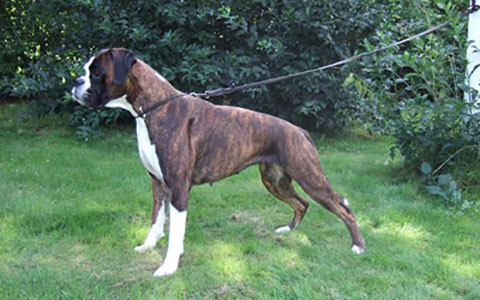Common boxer neoplasia
Home » Poodle Parent » Common boxer neoplasiaCommon boxer neoplasia
Common Boxer Neoplasia. Gastrointestinal Neoplasia in Boxers. Thyroid neoplasia is a common endocrine neoplasm in dogs. Local disfigurement and irritation necessitate excision which is usually successful. Lameness may be associated with metastasis to bone or skeletal muscle or with development of hypertrophic osteopathy.
 Boxer Mast Cell Tumour Ufaw From ufaw.org.uk
Boxer Mast Cell Tumour Ufaw From ufaw.org.uk
They can occur in any breed age or gender but mast cell tumors tend to occur in older dogs and are more common in breeds descended from the bulldog eg Boxers. However the areas where the neoplasia ends up will also send out signs of problems. Thyroid neoplasia is a common endocrine neoplasm in dogs. This type of cancer is painful and amputation of the affected limb is necessary to provide. Lymphoma is a common form of neoplasia in dogs and cats characterized by swelling of one or several lymph nodes in the body. Examples of these include.
The risk of a dog developing a mammary tumor is 05 if spayed before their first heat approximately 6 months of age 8 after their first heat and 26 after their second heat.
Osteosarcoma is the most common primary bone cancer in dogs. In the dog primary intracranial neoplasia represents 2-5 of all cancers and is especially common in certain breeds including English and French bulldogs and Boxers. Among dogs Afghans may be predisposed. Pancreatic exocrine neoplasia is an aggressive cancer that will spread to tissues that are nearby and even to the other organs throughout your dogs body. The oral cavity is a common site for tumors in dogs and cats and oral cancer is the fourth most common malignancy observed in dogs and cats. In addition diseases that hinder the bodys ability to absorb nutrients can cause excessive gas.
 Source: purinaproclub.com
Source: purinaproclub.com
This type of tumor accounts for roughly one quarter of all of the skin tumors that develop in dogs and it usually strikes dogs that are older than 8 years of age. The most affected breed were poodle 461326 boxer 27778 pitbull 19548 rottweiller 18519 and cocker spaniel 1749. Most dogs affected with this cancer are middle-aged to senior dogs. However the association between thyroid neoplasia malignancy and breed should. Age-adjusted data revealed a higher risk for boxers than nonboxers particularly.
 Source: researchgate.net
Source: researchgate.net
In cats one cause of. In the dog primary intracranial neoplasia represents 2-5 of all cancers and is especially common in certain breeds including English and French bulldogs and Boxers. The Bones Bone neoplasms are common in large and giant breeds of dogs. Hemangiosarcoma is a highly malignant cancer that can spread rapidly causing tumors almost anywhere in the body. Other reported canine GI neoplasms include carcinoid adenoma leiomyoma carcinoma in situ and.
 Source: researchgate.net
Source: researchgate.net
Gastrointestinal Neoplasia in Boxers. Bone cancer can affect any breed of dog but it is more commonly found in the larger breeds. Most dogs affected with this cancer are middle-aged to senior dogs. It is most often found in the dogs heart and spleen. This type of cancer is painful and amputation of the affected limb is necessary to provide.
 Source: ncbr.org
Source: ncbr.org
The most common oral neoplasms in the dog are malignant melanoma squamous cell carcinoma SCC fibrosarcoma and epulides. In the cat SCC in the most common oropharyngeal cancer followed by fibrosarcoma. 2487 were categorized as neoplasia. Therefore while it can occur at any age most owners need to keep an eye out for possible early warning signs once the dog has entered. Adenoma and adenocarcinoma of the meibomian gland are the most common lid neoplasms 60 in older dogs.
 Source: harlingenveterinaryclinic.com
Source: harlingenveterinaryclinic.com
Gastrointestinal Neoplasia in Boxers. Other reported canine GI neoplasms include carcinoid adenoma leiomyoma carcinoma in situ and. Generally these tumors are malignant and are most common in Airedales and Boxers. The overall prevalence of neoplasia in this population for the 12-year period was 42. Hemangiosarcoma is a highly malignant cancer that can spread rapidly causing tumors almost anywhere in the body.
 Source: harlingenveterinaryclinic.com
Source: harlingenveterinaryclinic.com
2487 were categorized as neoplasia. The most common oral neoplasms in the dog are malignant melanoma squamous cell carcinoma SCC fibrosarcoma and epulides. Generally these tumors are malignant and are most common in Airedales and Boxers. In the cat SCC in the most common oropharyngeal cancer followed by fibrosarcoma. The leg bones near joints are the most common sites.
 Source: vethelpdirect.com
Source: vethelpdirect.com
They can occur in any breed age or gender but mast cell tumors tend to occur in older dogs and are more common in breeds descended from the bulldog eg Boxers. Lameness may be associated with metastasis to bone or skeletal muscle or with development of hypertrophic osteopathy. In dogs adenocarcinoma is the most common gastric and large intestinal neoplasm whereas lymphoma is more frequently seen in the small intestine followed by adenocarcinoma and sarcomas such as gastrointestinal stromal tumor GIST and leiomyosarcoma. The oral cavity is a common site for tumors in dogs and cats and oral cancer is the fourth most common malignancy observed in dogs and cats. The most common types of primary intracranial cancer in the dog are meningioma glioma and choroid plexus tumors generally occurring in middle aged to older dogs.
 Source: ncbr.org
Source: ncbr.org
The most affected breed were poodle 461326 boxer 27778 pitbull 19548 rottweiller 18519 and cocker spaniel 1749. The most common oral neoplasms in the dog are malignant melanoma squamous cell carcinoma SCC fibrosarcoma and epulides. In addition diseases that hinder the bodys ability to absorb nutrients can cause excessive gas. Weight loss or abdominal swelling can be signs of abdominal neoplasia. The oral cavity is a common site for tumors in dogs and cats and oral cancer is the fourth most common malignancy observed in dogs and cats.
 Source: ufaw.org.uk
Source: ufaw.org.uk
In the cat SCC in the most common oropharyngeal cancer followed by fibrosarcoma. Canine oral neoplasia tumors occurs more frequently in males and commonly affected breeds include Cocker Spaniels Poodles Scottish Terriers Schnauzers Weimaraners Golden Retrievers and Boxers. This is a benign tumor of cells that differentiate toward the outer root sheath of the hair follicle. Lymphoma is a common form of neoplasia in dogs and cats characterized by swelling of one or several lymph nodes in the body. The leg bones near joints are the most common sites.
 Source: allboxerinfo.com
Source: allboxerinfo.com
Osteosarcoma tumors can spread from the bone to distant sites in the body including the lungs lymph nodes and other bones. Lymphoma is a common form of neoplasia in dogs and cats characterized by swelling of one or several lymph nodes in the body. Certain breeds namely those that are descended from bulldog lines have a much higher rate of tumor growth of this. The oral cavity is a common site for tumors in dogs and cats and oral cancer is the fourth most common malignancy observed in dogs and cats. However the areas where the neoplasia ends up will also send out signs of problems.
 Source: wikihow.pet
Source: wikihow.pet
Other reported canine GI neoplasms include carcinoid adenoma leiomyoma carcinoma in situ and. In regard to brain cancer if this type were to occur in a Boxer it usually develops after the age of 8. The highest relative risk was noted among boxers. Lameness may be associated with metastasis to bone or skeletal muscle or with development of hypertrophic osteopathy. Canine oral neoplasia tumors occurs more frequently in males and commonly affected breeds include Cocker Spaniels Poodles Scottish Terriers Schnauzers Weimaraners Golden Retrievers and Boxers.
 Source: boxerdogdiaries.com
Source: boxerdogdiaries.com
However the association between thyroid neoplasia malignancy and breed should. In dogs adenocarcinoma is the most common gastric and large intestinal neoplasm whereas lymphoma is more frequently seen in the small intestine followed by adenocarcinoma and sarcomas such as gastrointestinal stromal tumor GIST and leiomyosarcoma. Age-adjusted data revealed a higher risk for boxers than nonboxers particularly. This is a benign tumor of cells that differentiate toward the outer root sheath of the hair follicle. However the areas where the neoplasia ends up will also send out signs of problems.
If you find this site value, please support us by sharing this posts to your favorite social media accounts like Facebook, Instagram and so on or you can also bookmark this blog page with the title common boxer neoplasia by using Ctrl + D for devices a laptop with a Windows operating system or Command + D for laptops with an Apple operating system. If you use a smartphone, you can also use the drawer menu of the browser you are using. Whether it’s a Windows, Mac, iOS or Android operating system, you will still be able to bookmark this website.
